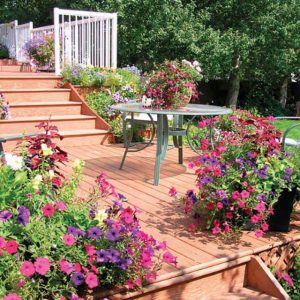Spring Home Improvement 2022

 Landscaping for Instant Curb Appeal
Landscaping for Instant Curb Appeal
(StatePoint) One of the best ways to achieve instant curb appeal, according to the experts, is to effectively layer shrubs, plants and flowers in your front yard. Doing so can create a cohesive visual experience that naturally guides visitors to the front door.
Landscape designer Doug Scott describes plant layering in art terms: “Just like in a painting, you need to have a background, a middle ground and a foreground. Each layer serves a purpose, and there’s no more important place for them to be on full display than your home’s entrance.”
To help homeowners understand the purpose of plant layering and identify the best types of plants for each layer, Scott has joined forces with Exmark, a manufacturer of commercial mowers and equipment for landscape professionals and serious DIY-ers. Here they break it down for you.
1. Background: The background layer should consist of taller evergreen shrubs to ensure that no matter what’s in front of them, you and your visitors will always have something green to look at. This layer provides a cohesive backdrop and a bit of living color in every season.
2. Middle Ground: Here’s where to step it down a notch in height and add interesting shapes, colors or stripes that provide contrast against the darker green of the background layer. Herbaceous perennials, like lavender, are a good choice for this purpose.
3. Foreground: Finally, the foreground layer should help transition the planting beds to your lawn space or sidewalk, and should therefore be lower than the back two layers. It’s also where you can keep things fresh and get your hands dirty throughout the year by changing out annuals with the seasons. Or, if you want a lower-maintenance entrance, you can choose smaller perennials, evergreens or creeping ground covers. Use the foreground layer as an opportunity to add pops of color at ground level and draw attention to your home’s entrance.
Scott lays out a few other important tips to keep in mind:
• Choose plants consistent with your home’s style. For instance, if you have a craftsman home, you should probably skip tropical plants. Or, if your home is more minimalist, avoid an overabundance of different plants.
• Don’t obstruct views of your front door from the street with plants. Likewise, visitors shouldn’t have to maneuver around plants as they make their way down the sidewalk. Neither is convenient or welcoming, so you’ll either need to keep pruning plants to size, or choose plants that won’t overgrow their space without a ton of pruning.
• To make your entrance “the star” it should be, the plant material in the rest of your front yard shouldn’t be distracting. Rather let it frame the intended view.
Scott offers more plant layering tips in “Making an Entrance,” a recent episode of “Done-In-A-Weekend Projects,” an original series from Exmark. To watch the video, visit Backyard Life, which is part of a unique multimedia destination with a focus on helping homeowners make the most of outdoor spaces. There you can also download additional tips and view other Exmark Original Series videos, including “Dream Yards,” “Living Rural,” “Prime Cuts” and “Done In a Weekend – Extreme Projects.”
Through effective plant layering, you can boost curb appeal and give your home the grand entrance it deserves.
* * *
Exterior Home Upgrades
 (StatePoint) Want to make some serious exterior home upgrades that improve your safety and comfort, add beauty to your home and deliver a return on your investment? Here are five projects that do just that:
(StatePoint) Want to make some serious exterior home upgrades that improve your safety and comfort, add beauty to your home and deliver a return on your investment? Here are five projects that do just that:
1. Install storm doors: Storm doors give you the option of letting in more light and ventilation on fair weather days, while protecting your entry door from harsh conditions and weathering. There are many ways to customize this upgrade to meet your aesthetic and functional needs.
Options from ProVia include retractable screens at the top and bottom for more venting options, as well as stylish designs and colors for instant curb appeal. Families might want to consider storm doors featuring heavy-duty, non-removable stainless steel screens ideal for keeping children and pets safely inside.
2. Get summer-ready: Extend your home’s outdoor living area just in time for summer—plus substantially increase your home value—with the addition of a deck,patio or porch. Whether you add a small hibachi grill or get as involved as installing a full outdoor kitchen, be sure to include an area to prepare and enjoy meals. A few key touches, like string lights and potted plants, along with cozy furniture, can make the space feel homey.
3. Lower bills: Did you know that you can lower your bills and add natural beauty and privacy to your property by planting trees strategically? In summer, the shade that trees create can help keep your home cool. In winter, they can help block wind and prevent drafts. The Utah State University Forest Extension recommends locating trees no closer than 2.5 times their mature height to the south of a building to avoid winter shading. They also suggest knowing the size and other characteristics of a particular species before planting to avoid future problems, such as hitting power lines.
4. Protect your home: If you live in an area prone to extreme weather—heavy rain, hail, driving wind, frigid temperatures, or scorching heat—your home needs protection against the elements. CedarMAX insulated vinyl siding provides defense against these harsh conditions and improves energy efficiency as well. The insulation contributes to the rigidity of the panel, increases durability, and provides five times greater impact resistance over hollow siding, protecting against damage by hail, high winds, or contact with your child’s fastball.
It’s important to see a tangible return on larger home upgrades. The best projects to consider are those that increase your home value, save you money, and add beauty and comfort to your home.
* * *
Tips to Start or Expand Your Garden
 (StatePoint) Starting a garden for the first time or expanding an existing plot is easier than you may think. With a little love and care, your green space will bloom.
(StatePoint) Starting a garden for the first time or expanding an existing plot is easier than you may think. With a little love and care, your green space will bloom.
“For anyone with the inclination, a beautiful lawn and garden is always within reach,” says Jamie Briggs, director of marketing, Exmark, a leading manufacturer of commercial mowers and equipment for landscape professionals and homeowners with a lot of lawn to cut. This is the driving idea behind “Backyard Smart,” a free online video series. These short explainer videos (visit exmark.com/backyard) are full of information to answer your most common lawn and garden questions. The following planting strategies come directly from two recent “Backyard Smart” episodes:
• Start With Seeds: Looking to add new plants to your garden and flower bed? Try starting from scratch. While most nurseries have limited species of mature plants to select from, there are literally thousands of varieties of seeds available at dirt-cheap prices. A quick trip to the seed kiosk in your local hardware store offers the potential for you to enjoy flowers you’ve never seen and vegetables you’ve never tasted.
“It’s easy to be intimidated by the prospect of growing plants from seeds but the truth is that all you need is soil, just the right amount of water and lots of sunshine,” says Briggs. “Nature will handle the rest.”
• Practice “Companion Planting”: Whether it’s growing marigolds alongside tomatoes to block bad bugs or planting corn next so squash to provide shade, plants are kind of like people—they do better with a buddy. Companion plants help block weeds, prevent pests, create fertile soil, promote pollination and offer plants a place to climb. In fact, people have been practicing this technique for centuries to create vigorous gardens.
If you’ve always dreamed of having your own, homegrown, fruits and vegetables in your cooking, or brightening your home with fresh-cut flowers, there is no better time than the long sunshiny days of summer to develop your green thumb.
* * *
Spring Hacks to Prep the Inside of Your Home for Warm Weather
(StatePoint) With warmer weather on the way, it’s time to deal with the associated household hassles of the season. Here are three hacks that will help you create a healthy, comfortable home during the months ahead.
Beat the Heat: Beyond having your HVAC unit serviced and changing your air filter regularly, you can beat the heat at home with a few smart strategies. One change you can make today that will also reduce your carbon footprint is to swap out your heat-emitting incandescent light bulbs for cool LEDs. Likewise, appliances that are not in use but plugged in could be generating unnecessary warmth, so unplug when you can. Finally, use shades and blinds strategically to block out the sun and prevent a greenhouse effect indoors.
Banish Flying Bugs: Fruit flies, gnats and flies tend to proliferate indoors in the warmer months. Not only do these creatures come with a serious ick factor, they can harm your houseplants and even put your family’s health at risk by carrying germs from dirty surfaces to clean ones.
A safe and easy way to defend against buzzing invaders is to plug Zevo Bug Traps into outlets around your home, especially in areas where these bugs enter your home and gather, like garages, entryways, covered porches, trash cans, drain pipes and kitchens. Rather than relying on chemical insecticides, they use multi-spectrum light technology that bugs find irresistible. Once attracted, flying insects are trapped in a super-sticky adhesive backing.
Each trap cartridge offers continuous defense for up to 45 days or until it’s full. When you’re done with a cartridge, simply throw it in the trash and slide a new one in, without ever having to touch the dead bugs. Pair these traps with Zevo home bug sprays, which are powered by essential oils, for whole home protection. To learn more about defending your home against insects, and for trapping tips, visit zevoinsect.com.
Master Mold: Thriving in warm wet environments, mold is something to watch out for at home, especially during spring and summer. Much more than an eyesore, mold is bad for your home’s infrastructure and bad for you. Mold can cause a number of allergic reactions and can sometimes even be toxic. However, you can reduce the risk of mold forming by managing your home’s humidity. Use fans and other ventilation in bathrooms and the kitchen when showering, running the dishwasher and doing other tasks that invite humidity. Test the humidity of various rooms in your home with a hygrometer and use a dehumidifier where needed.
According to the EPA, the ideal indoor humidity is between 30 percent and 50 percent.
Employing warm weather hacks at home can help you maintain clean, comfortable spaces, all season long.
* * *
Call 811 Before You Dig
April is Underground Damage Prevention Month in New Jersey. The Underground Facility Protection Act requires excavators and facility operators to participate in the State’s One Call system, also known as “Call Before You Dig.”
“New Jersey has one of the nation’s strongest and safest underground damage prevention programs and our plan is to keep it that way,” said Joseph L. Fiordaliso, president of the New Jersey Board of Public Utilities (NJBPU). “We implore you to notify the Call Before You Dig system prior to excavating to keep the public safe and to prevent serious injury or worse. By calling 811, you also help to protect underground infrastructure, especially pipelines, wires and cables.”
Excavations are the leading cause of damage to underground infrastructure. In CGA’s survey, homeowners’ most popular planned digging projects receiving citations are;
1) planting a tree or shrub;
2) building a patio or deck;
3) building a fence; and
4) installing a mailbox.
The law requires anyone who plans to dig to provide at least three business days’ notice before excavation, by calling 811, the New Jersey One Call Center, which operates 24 hours per day, seven days per week. Homeowners are encouraged to take the following steps whenever planning a digging project:
1) Plan ahead by calling 811 regardless of the depth or familiarity with the property;
2) Consider moving the location of the project if it is near utility line markings;
3) Confirm that all lines have been marked;
4) If a contractor has been hired, confirm that the contractor has called 811. Don’t allow work to begin if the lines aren’t marked.
When someone calls 811, the New Jersey One Call Center informs the owner of the nearby underground infrastructure. The owner (e.g., a utility) then visits the site and marks the underground facilities where the digging will take place. Respect the marks and dig with care by hand digging within two feet on either side of any marked facility.








